Two
Shipwrecks in the Sound of Mull
Duart Castle (Figure 23), ancestral home of the clan Maclean, has
watched a great deal of
history from its location guarding the Sound of Mull. We have conserved
material from two warships sunk in the 17th century whilst attempting
to subdue the Macleans. The oldest
vessel, the 'Swan', was lost in a
storm in 1653. The later vessel, the Dartmouth, sank in a heavy storm
on the evening of
October the ninth 1690.
Figure 23. Duart Castle
|
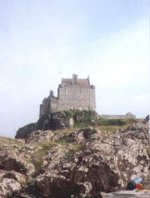
|
The Swan
Based on the designs of the
Dutch pinnaces of the time, she was built for Charles I in 1641. She
served the first part of the Civil War as an advice boat carrying
messages between royalist forces in Chester and Ireland. When pay ran
out, she switched sides, and was finally lost transporting troops in
the Sound of Mull for the Commonwealth government of Oliver Cromwell.
When the 'Swan' changed
sides the intricate carving from the superstructure, which betrayed her
Royalist origins were stowed in the hold (possibly ready for another
change of heart or fortune). As a result this has been preserved.
Normally the superstructure of a sunken ship is the last part to be
buried, and is exposed to aerated water for longer. This allows gribble
(limnoria lignorum) and other sea creatures to eat it away.
Much of the carving has
been conserved by conventional techniques by Theo Skinner, conservator
at the National Museums of Scotland. It was thought, however, that two
of the artefacts and some human bone would respond better to
Supercritical drying, and these were conserved at St Andrews (Figure
24).
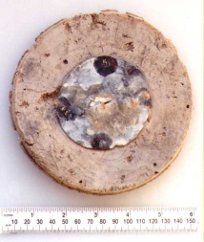 |
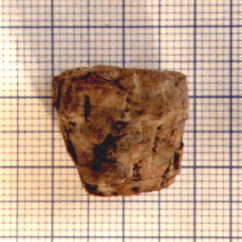 |
 |
| Compass base |
Cork bottle top |
Rapier handle |
Figure 24. Three items conserved from the
excavation of the Swan
|
The Dartmouth
Designed by John Tippets at
Portsmouth in 1655, the Dartmouth was a small, fast warship,
used for
commerce duties (raiding and protection). She had length at the keel of
80 feet (approximately 24 m), a burden of 266 tuns, and a crew of about
130 men. Whilst the Dartmouth had a long and relatively
trouble free
history in service, she had a major overhaul at Rotherhithe in 1678,
due to an infestation of shipworm (teredo sp.) which was sufficiently
bad as to require the replacement of her keel. Her ballast was reported
as being bad in November 1688, but this problem ought to have been
rectified during a refit at Plymouth in January of 1690.
In October of 1690, the Dartmouth, under Captain Edward
Pottinger, entered the Sound of Mull
to persuade the Maclean to sign the Articles of Allegiance to William
and Mary, by force if necessary. The Dartmouth took emergency
anchorage in the Sound during a storm on October 9th,
during which she developed a heavy list. Her anchor cables broke at
18:00 hours, and she drifted two miles before striking rocks on the
north shore of the sound. The Dartmouth sank with the loss of
all but six of her crew.
'The waves beat on her until
she went all to pieces there, to the great rejoicing of the Macleans'
Figure
25. The 'black box', a timber
from the Dartmouth, conserved by Supercritical drying. Note the
extensive tunnelling by
shipworm, exposed by erosion after sinking
We can probably discount
the accounts of witchcraft, but the sinking of the Dartmouth
does
have some unusual features - anchors were found on the ship, but
unused. What problem prevented the crew from deploying them? From the
historic account, we know that there was a problem with the ballast on
the ship in 1688, perhaps this had slipped. Alternatively, the
archaeology suggests that the hull may have given way under the
pounding of the storm, after having been weakened by shipworm attack.
The
Alderney Shipwreck
Dating from the
reign of Queen Elizabeth, this wreck was originally thought to be of
the
pinnace Makeshift, but is now believed to be of
a merchantman. Her cargo consisted of large amounts of arms and armour,
destined to supply troops engaged in denying Philip of Spain access to
French
Channel Ports in the years following the Spanish Armada.
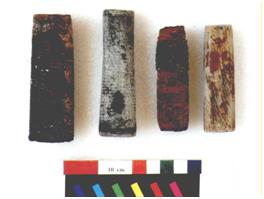 Amongst the
material recovered from the wreck in 1995 were some knife and sword
handles (Figure 26).
These had lost their blades to corrosion, but many retained traces of
their
tangs, protected by the wood. Amongst the
material recovered from the wreck in 1995 were some knife and sword
handles (Figure 26).
These had lost their blades to corrosion, but many retained traces of
their
tangs, protected by the wood.
Figure 26. A
collection of handles with metal wire grips. The first two from the
left are
weapons (detail - see photographs below), where the wire binding would
have
helped prevent the user from slipping on a wet handle. From paintings
of the
time we can guess that the smaller handles to the right belonged to
knives that
would have hung from the wearers belt, and used as eating implements
and
general-purpose tools
These artefacts
pose problems for conventional conservation techniques. Although good
conservation techniques do exist for wood and iron separately, they are
mutually exclusive. In consequence, supercritical drying, then an
experimental
technique, was used in an attempt to conserve the handles as complete
units.
The photographs below are of these handles after successful completion
of the
process.
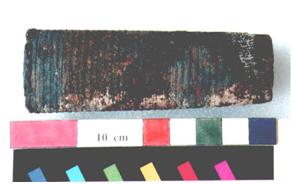 |
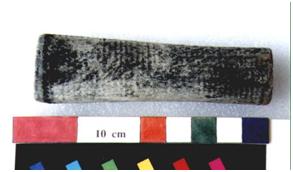 |
Figure
27. Once a fine sword handle, this composite artefact contained
elements of
wood,
cloth, copper braid, and the residue of an iron tang
|
Figure
28. A rapier handle, with only traces of the original braided wire grip
adhering to
the wood. The dark parallel striations are an image in corrosion
product of the
original wire
|
Ecofacts
Ecofacts are frequently as
important as artefacts; they constitute general environmental evidence
that might be entombed alongside that of human activity. The most
commonly analysed material is pollen, which can give a snapshot of the
environment in which the activity was occurring. The conifer cone shown
here is a macroscopic indicator of the type of environment.
It was also the most
complex conservation challenge we have faced to date. In an extremely
fragile condition when found, no conservation technique was thought up
to the challenge. Upon drying, the cones opened (as a modern cone
would). Unfortunately, the greatly weakened core was unable to support
the stress of this motion, and the cone collapsed under its own weight.
This left discrete piles of bits that had to be cleaned,
consolidated and reassembled, as documented in the
accompanying photographs.
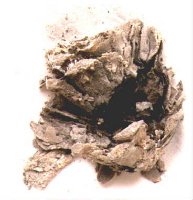 |
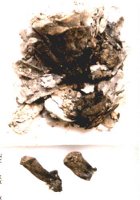 |
| 1. The cone
after
drying. It had collapsed and separated into two major parts, the core
and the base, as well as many smaller fragments |
2. The cone was
too
weak to move as a complete unit, so many fragments had to be cleaned
and consolidated separately |
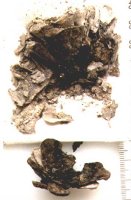 |
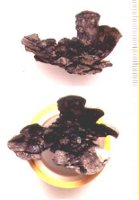 |
| 3. The base was
extracted almost complete. Shown here partially consolidated before
moving |
4. The base was
strengthened or consolidated by applying several coats of polymer
solution |
 |
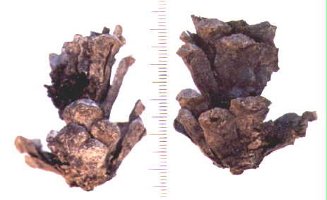 |
| 5. The core was
carefully cleaned and consolidated |
6. The base and
the
core were reunited |
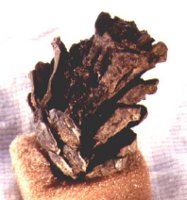 |
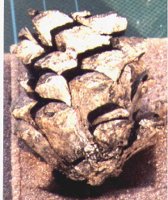 |
| 7. Supported in
a
foam collar, the cone could be tipped to allow re-insertion of the
smaller fragments that had been conserved separately |
8. Almost
finished!
Excess polymer was removed by gentle brushing with acetone, to reduce
the gloss finish |
 |
| 9. The conifer
cone
after supercritical drying and consolidation |
Ecofacts
might be as important as artefacts to the scientific study of an
archaeological site, but it is doubtful that their display potential
warrants the two months of work that was required to complete
conservation of the cone above.
SOMAP 98
- NAS training school
The three artefacts below all come from SOMAP 98,
a training school run by the Nautical Archaeology Society. The work in
the Sound of Mull that August involved surveying the John Preston, a
wooden sailing ship that sank with a full load of roofing slates
shipped from Port Dinorwic in North Wales, and the Scallastle
Bay
Cannons, a group of muzzle loading iron guns. The Scallastle
Bay
Cannons were thought to have been jettisoned by the Dartmouth
on
October the 9th 1690, just before being blown
out of control across the
Sound to be wrecked off the mainland coast. The clay pipe
fragment
excavated from beneath one of the cannon, however, indicates
that this
ordinance probably dates from after the Napoleonic Wars (early 19th
century).
Two of the guns were identified. One is an Armstrong pattern gun dating
from about
1785, and possibly manufactured by the Carron Co. (who developed the
"Carronade" or "smasher"). The other is a Blomefield gun, which
superseded the Armstrong pattern, and was in use up to 1805. As the
Dartmouth sank in 1690, these cannot be her guns. The dates of these
weapons are consistent with that given by the clay pipe fragment (ca.
1800 to 1830).
| ITEM
1: Clay
pipe fragment (bowl) |
| Archaeological
Data |
Site:
Scallastle Bay Cannons Site
Context: Beneath
one of the cannons, and possibly dating this site
|
|
Notes: The bowl
is cast with a raised Hand of Ulster and oval bearing the indented
initials (R?) M. Cleaning during conservation confirmed the inscription
to be 'RM'. These initials may be scratched in (that is an owners
mark), or introduced as part of the casting (a makers mark). The oval
about RM is raised from the body of the pipe bowl, and therefore cast
with the bowl. |
|
Conservation
Data
|
|
Lab ref : BA853
|
External ref :
SOMAP 98
|
Material(s):
Unglazed ceramic
Analysis: Gravimetry only, 14.433 g wet
weight as origin. Mass loss on acid treatment equivalent to 3% of the
original mass. Final dry weight after cleaning 11.158 g (a fairly
porous ceramic).
Notes: Item from
a seawater environment, stained black with some red/brown colour in
patches (iron oxide). Ceramic is robust, but scratched and chipped
along the bowl rim, and missing the stem from close to the bowl.
|
Conservation
plan: Full recording, including
all dimensions (not shown in accompanying images). Stepwise reduction
of salt-water concentration, followed by treatment with 1M hydrochloric
acid to remove staining. Complete desalination to chloride free
distilled water. Air dry and display.
Plan updates: Hydrochloric acid stripped out
iron, leaving clear white ceramic showing in patches. Much of the black
colour is, however, a surface bio-film that cannot be removed
mechanically. Organic film peeled on drying from acetone, removed by
brushing. Some surface damage during cleaning indicated by traces of
ceramic powder. Damage is not visible to the naked eye, but may be
apparent under magnification. Inscription is now clear, 'RM'.
Current status:
Completed
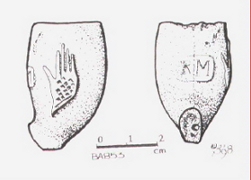 |
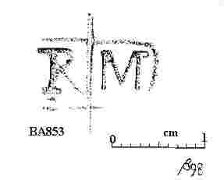 |
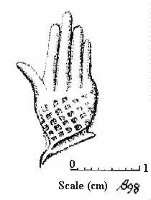 |
| Prior to conservation |
Close up of initials drawn after cleaning
|
Close up of hand drawn after cleaning |
Figure 29. Drawings
|

|
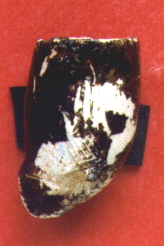
|
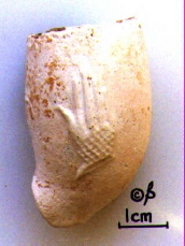
|
| As origin (wet) |
After acid wash (wet) |
After completion (dry) |
Figure 30. Photographs
|
The
dark colour of
the artefact as it was found (1 above) was due to a combination of
contamination, and the darkening
effect of water present within the
porous structure of the ceramic. One contaminant was
iron, derived from
corrosion of the cast iron cannon, from below which the pipe was
excavated. Iron salts are commonly red-brown in colour, though black
iron sulphide may also be formed in reducing environments. The iron
salts were removed by washing in hydrochloric acid, the effects of
which can be seen in photo 2 above. The other contaminant was a thin
organic film on the surface of the pipe. This film was removed by
mechanical cleaning in acetone. Small patches of this film are still
present in photo 3 above, but the decoration on the pipe (the Hand of
Ulster) is now clearly visible.
|
| ITEM
2: Lead Gun
Apron
|
|
Archaeological Data
|
Site:
Scallastle Bay
Context:
Originally associated with cannons, but uncovered between 1997 and 98,
and mobile on the sea floor
|
|
Notes: Aprons
were used to prevent water entering the touch-hole of the gun. When in
place the gun could be kept loaded and ready for action. A tampion
would have prevented water entering through the muzzle of the gun.
|
|
Conservation Data
|
|
Lab ref : BA854
|
External ref: SOMAP 98
|
Material(s) : Lead
Analysis : Corrosion potential only
Notes : Lead
apron is scratched and dented, with some adhering concretion and marine
life, but bears no apparent graffiti
|
Conservation
plan: Record - photographic and
dimensioned drawings including profiles. Stored in 0.05M sodium
sulphate solution in fresh water to prevent oxidation (CP measured =
-360 to -375 mV vs. Ag/AgCl). Treat with dilute sulphuric acid (0.5M or
1N) to remove concretion and adherent biological contamination (CP of
the Pb in acid with aluminium anodes attached = -650 mV vs Ag/AgCl).
Soak in fresh water and dry ready for display.
Plan Updates: Experimental studies confirm
that cathodic protection during acid treatment is valuable in
preventing the formation of surface lead sulphate. Close anode location
allows cleaning to a bright metal surface which acquires a dull white
patina over a period of days exposure to air (lead carbonate or oxide).
Treatment of the apron revealed large amounts of sulphide salts
(presumably iron) embedded within the surface concretions, this results
in considerable stench upon treatment with acid (liberation of hydrogen
sulphide).
Current status: Completed
Figure
31. Drawing
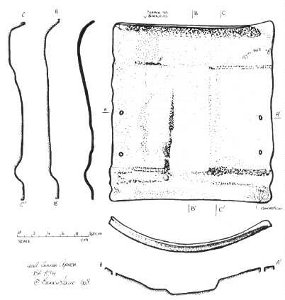
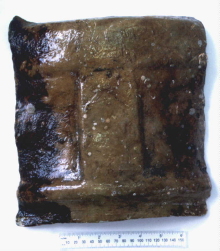 |
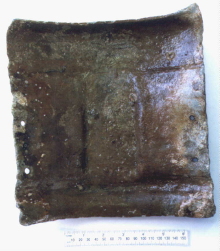 |
Figure
32. Photographs of the apron prior to conservation. Note the apron was
moulded to the cannon's shape (left if upper surface, convex)
|
|
|
ITEM 3 :
Wooden sheaf
|
|
Archaeological Data
|
Site:
John Preston
Context: None
|
| Notes: Of
no
archaeological value, this item
was raised by a sports diver and kept
wet in a drain from a domestic sink. The sheaf would have acted as a
pulley wheel in a lifting block, as shown in the sketch above.
|
|
Conservation Data
|
|
Lab ref : BA855
|
External ref:
SOMAP 98 |
Material(s):
Wood
Analysis: Microscopic analysis for species
(in progress)
Notes: Very
badly worm eaten and contaminated by modern food residues. This is not
a nice artefact. It may be useful in evaluating treatments for two
other sheaves undergoing conservation at the laboratory, however.
|
Conservation plan: Record - photographic and
dimensioned drawings, wet weight. Treatment with 1M hydrochloric acid
to remove iron contamination and sterilise item. Clean than replace all
water with methanol and attempt to remove fats. Supercritical drying.
Plan Updates:
Current status: Completed
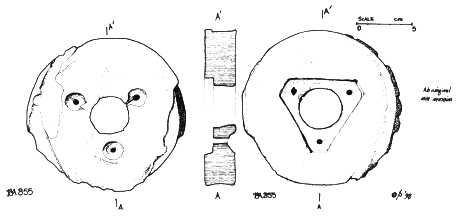
Figure
33. Drawing (scale bar is 5 cm long)
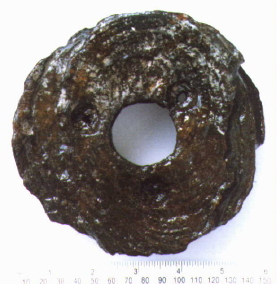 |
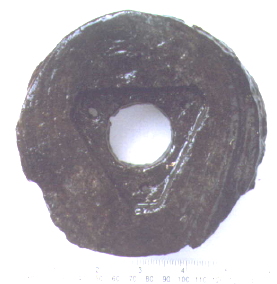 |
Figure 34. Photographs
|
Above
left, sheaf showing screw holes around the large central hole through
which the axle would have passed. The screws held a cast iron bearing
in place. Above right, view of the other side of the sheaf, showing the
triangular recess in which the cast iron bearing sat. The bearing,
screws, axle and other iron fittings have corroded away. These
photographs were taken before conservation work commenced. Due to the
dark colour of this artefact, these photographs have been processed so
that detail can be seen.
|
Ruben Duque 2011.
All rights reserved
|